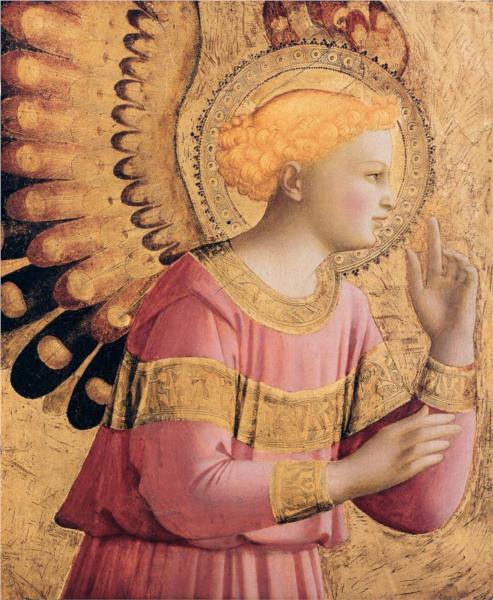Are Angels Real?

Angels surround us all the time — figuratively if not literally — especially during the holidays. They appear in paintings, etchings, figurines, T-shirts, posters and just about everything else. Angels appear in several religions; for example, in Islam, angels are said to be made of light, while Christian angels were willed into being by God.
Early versions of angels had no gender, though later Christian angels were tall, slender males with soft features, often dressed in flowing robes specially tailored around their large white wings. Angels are said to be either immortal or greatly long-lived.
Though originally they were specifically religious figures, angels have become more secular over the years, and today they are widely associated with the New Age movement populated by pagans, atheists and those who consider themselves "spiritual." Books about angels and angelic contact are enormously popular, with titles like "Where Angels Tread" and "Angels: Who They Are and How They Help." They typically contain discussions of angels in scripture along with heartwarming true stories of modern-day miracles attributed to the heavenly visitors. Popular television shows such as "Highway to Heaven" (1984-1989) and "Touched by an Angel" (1994-2003) helped cement the prominence of angels in American popular culture.
Angels occasionally feature in reports of near-death experiences, though mostly in those who have a pre-existing belief in them. Among UFO believers, some claim that alien abductors are actually angels instead of extraterrestrials. Erich von Daniken, for example, author of several popular (if scientifically dubious) books in the 1970s, claimed that Biblical stories of Abraham and Joseph describe them meeting aliens, not angels.
Religious angels
The word "angel" comes from the Greek word "anglos," which means "messenger" in Hebrew. Angels can take many forms, usually appearing as human or a glowing light or aura. Often — especially in cases of averted tragedy or disaster — angels will not be seen at all, but instead their presence recognized by their actions. If something good, unexpected, and seemingly inexplicable happens, it's often assumed to be the result of divine or angelic intervention.
The angels most people are familiar with today are the Christian angels, which originated from the Hebrew Testaments. The Catholic Church devoted considerable effort to describing and developing an extensive hierarchy of angels. There were many different types of angels, archangels, seraphim, and so on, with an official census of nearly half a million.
In his book "A Dictionary of Angels" (The Free Press, 1967) researcher Gustav Davidson devotes nearly 400 pages to identifying and listing angels. Many angels were created (or endorsed) by religious authorities, but others were fabricated by quasi-religious scholars and laypeople. As Davidson notes, "To invent an angel, a hierarchy, or an order in a hierarchy, required some imagination but not too much ingenuity. It was sufficient merely to 1) scramble letters together of the Hebrew alphabet; 2) juxtapose such letters in anagrammatic, acronymic, or cryptogrammatic form; and 3) tack on to any place, property, function, attribute or quality" using the suffixes "-el" or "-irion." Thus, according to Davidson, "Hod (meaning splendor) was transformed into the angel Hodiel." In this way, just as the ancient Greeks essentially created a pantheon of gods to worship, angel enthusiasts created a pantheon of angels—some more historically legitimate than others.
Get the world’s most fascinating discoveries delivered straight to your inbox.
In Christianity and Islam, angels function mainly as God's messengers (mostly announcing births and deaths), but in modern times they function more as guardians. Indeed, the word "angel" has come to describe any hero or benefactor. Though angels, by their nature, serve God, they also serve mankind directly. Angels perform a wide variety of tasks, from healing the sick and finding lost keys to smiting enemies and, of course, winning football games. Many believe that angels come when summoned, and there is a long tradition of people using magic spells and charms to bring angels to them.
'Real angels'
Despite centuries of theological speculation about angels — from their number to their duties to how many can dance on the head of a pin — no one knows if they exist outside of stories and legends. Many people believe they do.
Plato and Aristotle, for example, were convinced that they exist. In modern times, polls suggest that nearly 70 percent of Americans think angels are real. In their book "Paranormal America," sociologists Christopher Bader, F. Carson Mencken and Joseph Baker note, "Angels pervade popular culture in books, television shows, and movies. ... Believers exchange informal testimonials in newsletters and interpersonal conversations about the potential power of angels to influence the world, and more than half of Americans (53 percent) believe that they have personally been saved from harm by a guardian angel."
A 2007 Baylor Religion Survey found that 57 percent of Catholics, 81 percent of black Protestants, 66 percent of Evangelical Protestants, and 10 percent of Jews reported having a personal experience with a guardian angel. And 20 percent of those who identified themselves as having no religion also claimed having encountered an angel.
In one famous 2008 angel encounter, a North Carolina woman named Colleen Banton claimed that an angel miraculously healed her daughter. While in a hospital's waiting area, Banton noticed that a patch of sunlight appeared through a nearby window and shone in the hallway outside her daughter's room. Her daughter soon got better, and Banton attributed the recovery to the angelic visit. (While everyone was glad at the girl's recovery, others noted that the patch of sunlight regularly appears in that spot, at the door of patients who both do and don't recover.)
Though angels are said to dwell in heaven, their visits to the earthly realm are not always benevolent. The most famous angel, of course, is Satan, who rebelled against God and was cast out of heaven. He started his own outfit and has been doing well ever since. Biblical angels wage warfare, lay siege to cities and kill people. The archangel Michael, for example, is often depicted as the leader of God's Army, destroying armies with his terrible powers and flaming sword. These avenging angels seem to have disappeared in modern times in favor of the benevolent variety.
Angels are enduringly popular for many reasons, including that they represent unconditional love and appeal to personal experience. Any good luck, meaningful coincidences or unexpected pleasant surprises can be interpreted as the work of angels. Whether real or fictional, angels have been with humans for millennia, and their presence will continue to comfort.
Benjamin Radford is deputy editor of Skeptical Inquirer science magazine and author of six books including Scientific Paranormal Investigation: How to Solve Unexplained Mysteries. His website is www.BenjaminRadford.com.

